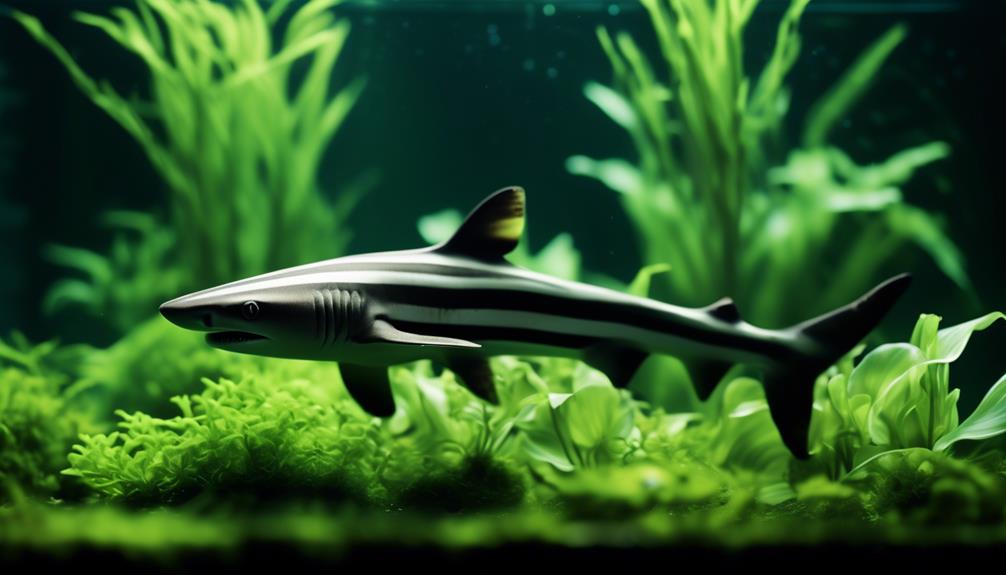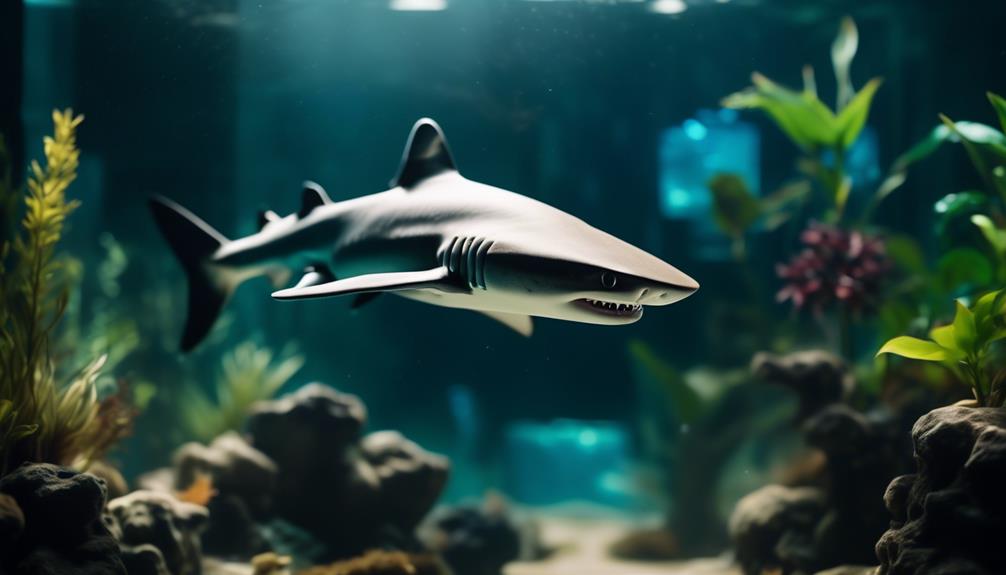Are fierce freshwater sharks truly the ideal aquatic pets? While many may associate sharks with the deep seas and saltwater habitats, there are actually several species of freshwater sharks that can thrive in home aquariums.
These captivating creatures not only provide a sense of excitement and thrill, but they also add a unique and dynamic element to any aquarist's collection. But what makes these freshwater sharks so special? And how can they be properly cared for in a home aquarium?
In this discussion, we will explore the fascinating world of fierce freshwater sharks and uncover why they may just be the perfect addition to elevate your aquatic experience.
Key Takeaways
- Red Tail Sharks and Rainbow Sharks are freshwater species that require well-decorated tanks with hiding spots to enhance their natural habitat and for breeding.
- Breeding the Roseline Shark in captivity is difficult, and it is best kept with rainbowfish and larger livebearers.
- Siamese Algae Eaters are peaceful fish that have a voracious appetite for algae and can be kept with various tank mates.
- Bala Sharks are freshwater species that require large tanks, at least 6 feet in length, and a balanced diet of pellets, flakes, and frozen foods for their health.
Red Tail Shark and Rainbow Shark
The Red Tail Shark and Rainbow Shark, scientifically known as Epalzeorhynchos bicolor and Epalzeorhynchos frenatus, respectively, are freshwater species that make fascinating additions to aquariums. These sharks have unique breeding habits and specific tank decoration preferences.
Red Tail Sharks are known to be territorial and aggressive during breeding. To create an ideal environment for breeding, it's recommended to provide caves or hiding spots in the aquarium.
Rainbow Sharks, on the other hand, are less aggressive during breeding but still require hiding places to lay their eggs. Both species prefer well-decorated tanks with plenty of hiding spots, such as rocks, caves, and driftwood. The addition of live plants can also enhance their natural habitat and provide additional hiding places.
Roseline Shark
After exploring the breeding habits and tank decoration preferences of the Red Tail Shark and Rainbow Shark, it's now time to focus on the Roseline Shark.
The Roseline Shark, scientifically known as Sahyadria denisonii, is a freshwater species that grows to a size of 4-5 inches (10-13 cm). Similar to the Red Tail Shark and Rainbow Shark, the Roseline Shark requires a minimum 4-foot (1.2 m) long aquarium to thrive.
When it comes to breeding, the Roseline Shark is known to be difficult to breed in captivity, with successful breeding attempts being rare.
In terms of tank mates, the Roseline Shark is best suited to be kept with rainbowfish and larger livebearers.
Siamese Algae Eater

The Siamese Algae Eater, scientifically known as Crossocheilus sp., is a freshwater species that can reach a size of 6 inches (15 cm). This species has distinct behavioral characteristics that make it an ideal addition to an aquarium.
Here are some key points to consider when setting up a tank for Siamese Algae Eaters:
- Tank setup and decorations:
- Provide ample hiding places such as caves, rocks, and driftwood to mimic their natural habitat.
- Ensure the tank has plenty of swimming space, as Siamese Algae Eaters are active swimmers.
- Use live plants to create a natural environment and provide additional hiding spots for the fish.
- Behavioral characteristics:
- Siamese Algae Eaters are known for their voracious appetite for algae. They can help control algae growth in the aquarium.
- They're peaceful fish and can be kept with a variety of tank mates, as long as they aren't aggressive or territorial.
- Siamese Algae Eaters are active during the day and prefer a well-lit aquarium.
Bala Shark
Moving on to the next species of freshwater shark, we now turn our attention to the Bala Shark, scientifically known as Balantiocheilos melanopterus.
The Bala Shark can reach a size of 12 inches (30 cm) and requires a tank with at least 6 feet (1.8 m) in length to ensure its well-being.
When it comes to tank compatibility, the Bala Shark can coexist with larger cichlids, catfish, and gouramis.
As for feeding and care, this species thrives on a diet of pellets, flakes, and frozen foods. It's important to provide a balanced diet to maintain their health.
Additionally, regular water changes and monitoring of water parameters such as pH levels between 6-8 and temperatures from 72-80°F (22-27°C) are essential for their optimal growth and development.
General Information

Freshwater sharks, including the Red Tail Shark, Rainbow Shark, Roseline Shark, Siamese Algae Eater, and Bala Shark, require specific tank sizes and water parameters to ensure their well-being and optimal growth. These requirements include pH levels between 6-8 and temperatures ranging from 72-80°F (22-27°C).
Tank size considerations are also important, with the Red Tail Shark and Rainbow Shark needing a minimum 4-foot (1.2 m) long aquarium, while the Bala Shark requires a tank with at least 6 feet (1.8 m) in length.
It's crucial to provide the appropriate tank mates for these sharks, such as larger cichlids, catfish, gouramis, rainbowfish, and bigger livebearers.
Frequently Asked Questions
Can Red Tail Sharks and Rainbow Sharks Be Kept Together in the Same Aquarium?
Red tail and rainbow sharks can be kept together in the same aquarium, but caution is advised. They have similar sizes and behaviors, but red tails can be more aggressive. Monitoring their interactions is crucial for their well-being.
What Are Some Suitable Tank Mates for Roseline Sharks?
Suitable tank mates for Roseline Sharks include rainbowfish and larger livebearers. It is important to consider compatibility when keeping different shark species together in the same aquarium to ensure their well-being.
Can Siamese Algae Eaters Live in a Community Tank With Other Fish Species?
Siamese algae eaters can live in a community tank with other fish species. They have a diet that includes black beard algae and other types of algae. Proper care and suitable tank mates are important for their well-being.
How Big Do Bala Sharks Grow and What Size Tank Do They Require?
Bala sharks can grow up to 12 inches and require a tank with a minimum length of 6 feet. To ensure their well-being, it is crucial to provide them with the ideal tank size and necessary care.
Are There Any Specific Water Parameters That Need to Be Maintained for the Well-Being of These Freshwater Shark Species?
Water parameters for freshwater sharks, such as red tail and rainbow sharks, include pH levels between 6-8 and temperatures of 72-80°F. Compatibility of these species should be considered when selecting tank mates for a well-balanced aquatic environment.
Conclusion
In conclusion, the world of freshwater aquariums offers a diverse range of shark species that can make ideal aquatic pets.
From the active and vibrant Red Tail Shark and Rainbow Shark to the elegant Roseline Shark, these creatures bring excitement and beauty to any collection.
The Siamese Algae Eater provides a practical solution for combating unwanted algae, while the grandiose Bala Shark adds a majestic touch to larger tanks.
Explore the captivating world of fierce freshwater sharks and elevate your aquarium to new heights.

